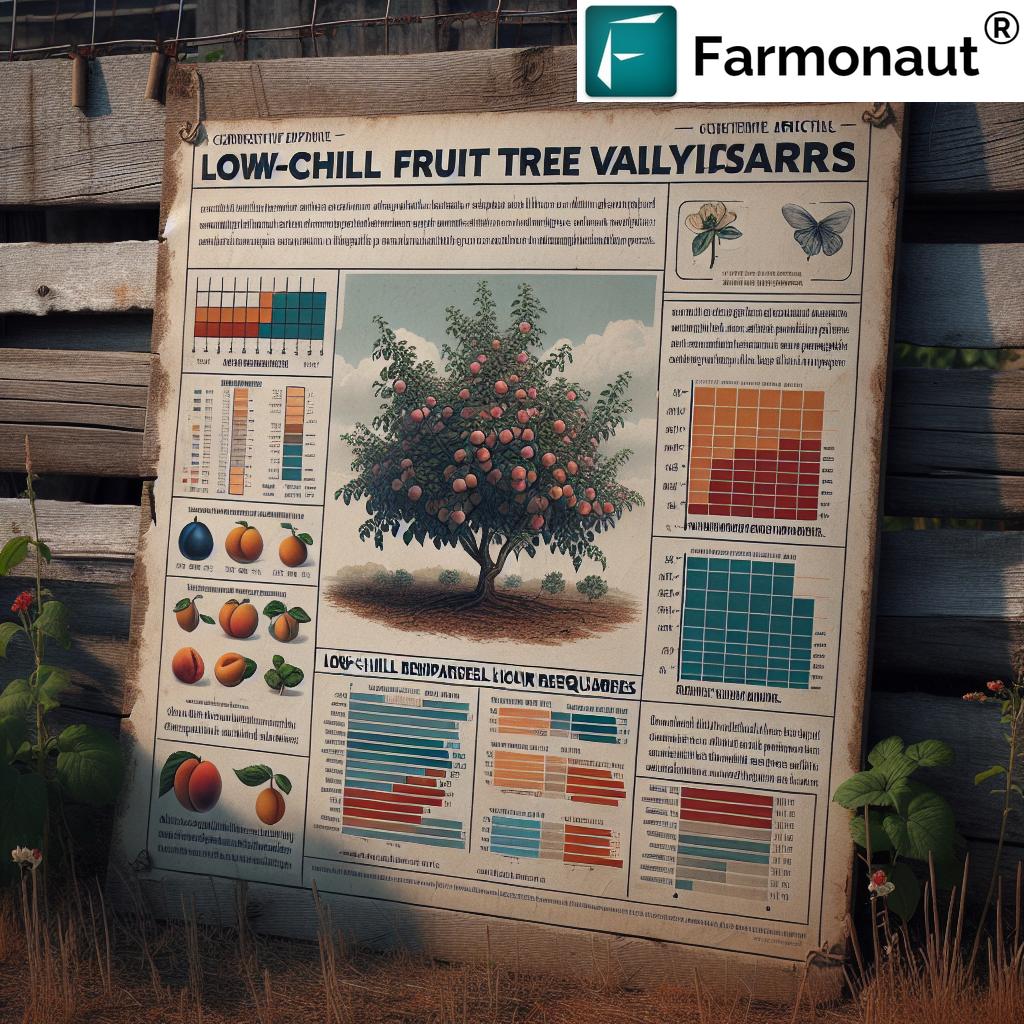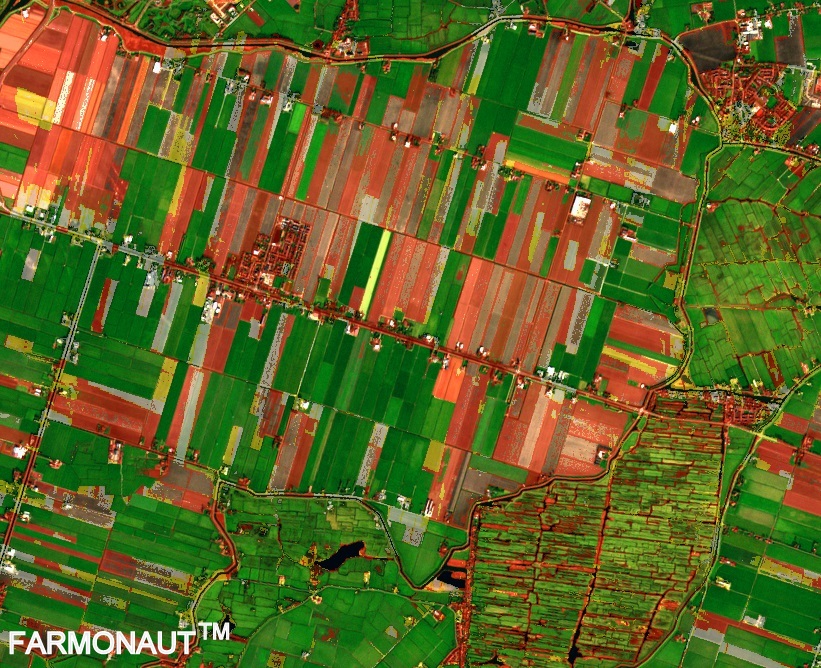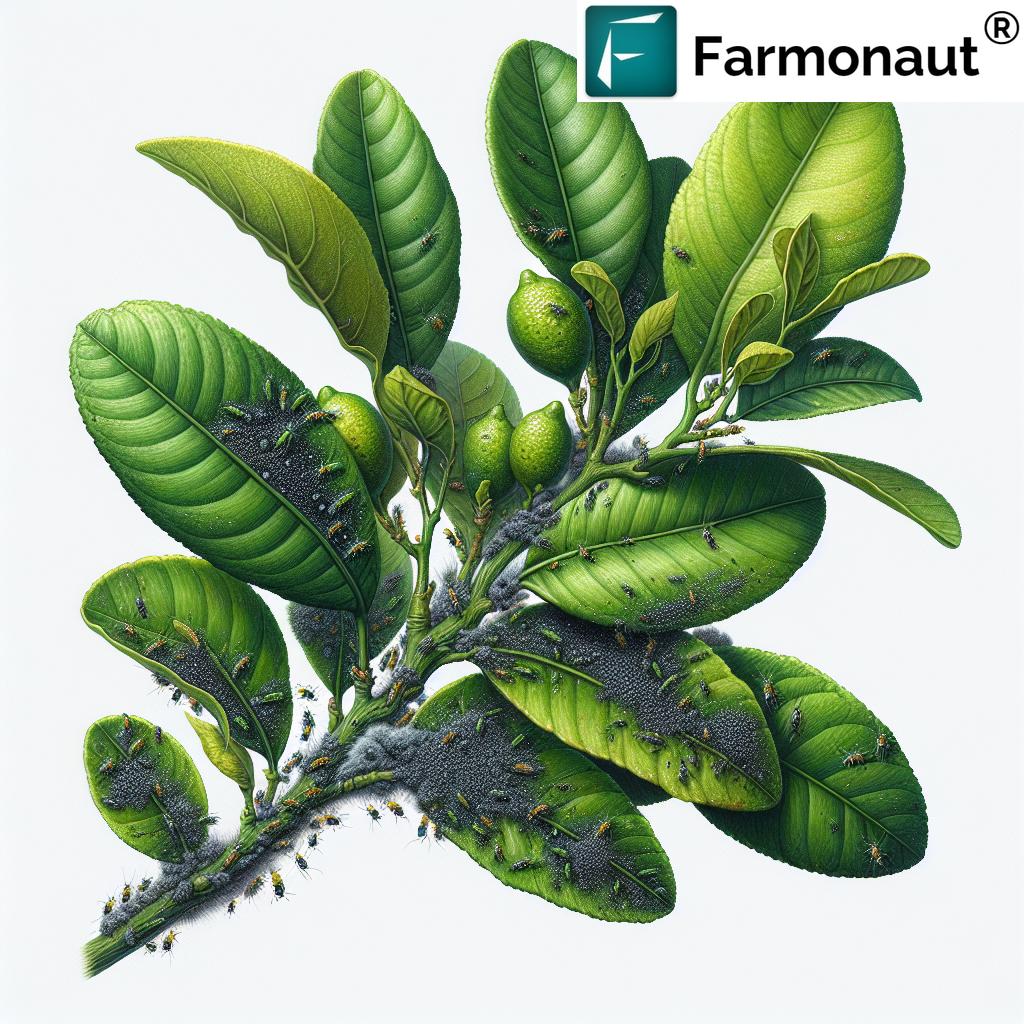Table of Contents
- Introduction: Understanding Chill Hours for Fruit Trees
- What are Chill Hours? The Science Behind Fruit Tree Dormancy
- Why Chill Hours Matter for Fruit Tree Production
- Fruit Tree Chill Hours & Climate Adaptation Comparison Table
- Estimating & Calculating Chill Hours: Methods & Models
- Climate Impact on Fruit Trees: Changing Chill Hours and Their Effects
- Chill Hours for Fruit Trees: 7 Climate Success Tips
- Farmonaut’s Role: Precision Climate Monitoring & Data-Driven Decisions
- Frequently Asked Questions
- Conclusion
“Apple trees need 800–1,000 chill hours; advanced climate models now predict chill hour shifts with 90% accuracy.”
Chill Hours for Fruit Trees: 7 Climate Success Tips
The success of fruit tree production—especially in temperate regions—hinges on a fascinating, science-backed phenomenon: chill hours for fruit trees. As we face accelerating climate shifts, understanding and adapting to changes in chill hours has become a critical factor that separates thriving orchards from those facing unpredictable bloom, poor fruit set, and disappointing harvests.
In this comprehensive guide, we’ll explore what chill hours are, how they interact with tree dormancy and physiological needs, and why they are pivotal for flowering and fruiting success. We’ll deep-dive into chilling hours models, common fruit species and their specific temperature requirements, real-world chill hour calculation strategies, and the emerging role of technology & innovation—including solutions from Farmonaut—to ensure success in a changing climate.
Whether you’re a commercial orchard manager, a backyard grower, or an agricultural advisor, integrating this knowledge is vital to meet fruit tree dormancy requirements, choose the best fruit tree varieties for warm climates, and develop robust strategies for managing chill hours in your location.
What are Chill Hours? The Science Behind Fruit Tree Dormancy Requirements
Chill hours, also referred to as chilling units, are the cumulative number of hours during the winter season when temperatures remain between 32°F (0°C) and 45°F (7°C). During this period, fruit trees in temperate zones enter a critical stage of dormancy—a physiological rest phase where buds prepare to bloom and fruit when warmth returns.
Why do fruit trees require this chill? The answer lies in their evolutionary adaptation to survive freezing conditions. If trees fail to receive adequate chill, their dormancy-breaking mechanism malfunctions: bud break is erratic, flowering is delayed or incomplete, and yields drop dramatically.
Conversely, excessive cold exposure can also cause bud damage and negatively impact the next growing season. That’s why understanding—and accurately calculating chill hours—is essential.
Physiological Needs of Temperate Fruit Species
- Resetting the Clock: For many temperate fruit tree species (apple, pear, peach, plum, cherry, and others), sufficient chill is required to “reset” their internal growth calendars, ensuring healthy, synchronized bloom and fruiting.
- Chill Deprivation Symptoms: When chill hours are insufficient, trees exhibit symptoms such as poor bloom, uneven leaf emergence, reduced fruit set, and lower fruit quality.
- Adaptation to Climate: Cultivation success depends on matching cultivars to the local chill pattern—with high-chill species thriving in cooler zones, and low-chill varieties bred for mild climates.
Why Chill Hours Matter for Fruit Tree Production: The Link to Climate, Flowering & Fruit Set
Ensuring the right chill hour match between a region’s winter climate and a species’ chill requirement is one of the most important decisions in fruit tree cultivation.
Key Impacts of Chill Hour Mismatch
- Delayed or Poor Bud Break: Trees may not exit dormancy uniformly, causing weak blooming and uneven fruit development across the growing season.
- Reduced Yield and Fruit Quality: Insufficient chilling leads to limited fruit set, smaller or misshapen fruit, and lower overall yield.
- Fertility Issues: Pollination problems arise when flowers bloom at unpredictable times, reducing cross-fertilization and harvest outcomes.
- Physiological Stress: Trees experience stress if their climatic and physiological needs aren’t met—making them more prone to disease, pest attack, and environmental damage.
For growers and orchard managers, aligning the climate impact on fruit production with accurate knowledge of ideal chill hour requirements can save years of effort and boost both sustainability and profitability.
Fruit Tree Chill Hours & Climate Adaptation Comparison Table
Choosing the right varieties—and deploying proven strategies—is far easier when you can quickly compare chill requirements, dormancy periods, climate zones, major regions, and adaptation recommendations. Use this SEO-optimized comparison table as your foundation for planning new plantings or adapting existing orchards to current climate patterns.
| Fruit Tree Species | Estimated Chill Hours Needed | Typical Dormancy Duration | Preferred Climate Zone | Major Growing Regions | Recommended Adaptation Strategies / Tech |
|---|---|---|---|---|---|
| Apple | 500–1,000 | 10–12 weeks | Temperate, continental | California, Europe, China, North India |
|
| Apricot | 400–1,000 | 8–10 weeks | Mediterranean, cold-winter | Mediterranean Basin, California, Turkey |
|
| Peach | 400–800 | 8 weeks | Temperate, semi-arid, subtropical | Southeast US, Spain, Italy, China |
|
| Pear | 400–900 | 8–12 weeks | Temperate, mountainous | China, US, Central Europe |
|
| Plum | 400–700 | 6–8 weeks | Temperate, continental | Japan, Europe, US |
|
| Cherry | 500–700 | 8–10 weeks | Temperate | Turkey, US NW, France, Germany |
|
| Almond | 400–600 | 6–8 weeks | Warm temperate, Mediterranean | California, Spain, Italy, Iran |
|
| Blueberry | 150–700 | 6–10 weeks | Temperate, subtropical | US, Poland, Australia, Chile |
|
| Blackberry | 200–600 | 5–8 weeks | Mild, coastal, temperate | US, Mexico, UK |
|
| Grape | 100–600 | 4–8 weeks | Temperate, Mediterranean | Italy, France, Spain, California |
|
| Pecan | 300–500 | 5–7 weeks | Warm temperate, subtropical | Southern US, Mexico, Australia |
|
| Persimmon | 200–400 | 4–6 weeks | Mild winter, subtropical | China, Japan, Mediterranean |
|
| Pomegranate | 100–200 | 2–4 weeks | Arid, semi-arid, subtropical | India, Iran, Mediterranean |
|
| Strawberry | 200–400 | 4–7 weeks | Mild winter, temperate | California, Europe, Korea, Mexico |
|
This table makes it clear—knowing your region’s chill profile, matching it with the right species and varieties, and leveraging innovative adaptation strategies is the shortest route to fruit production success.
Estimating & Calculating Chill Hours: Proven Methods & Advanced Chilling Models
The ability to calculate chill hours for a given location—accurately and in real-time—is vital for growers, advisors, and researchers. Fortunately, scientific models and modern digital tools (like those accessible through Farmonaut) are revolutionizing how we track chill patterns and predict dormancy fulfillment for various fruit tree species.
How to Calculate Chill Hours
- Chilling Hours Model: The earliest and simplest; it counts the total hours within the range of 32°–45°F (0°–7°C) during fall and winter. Still widely used for quick assessments.
- Utah Model: Recognized for improved accuracy in variable climates, the Utah Model assigns different chill unit values depending on the temperature window (accounting for both positive and negative contributions). For instance, hours above 60°F can negate chill accumulation.
- Dynamic Model: The most advanced; it considers progressive, multi-stage chill accumulation and memory effects. This model is highly accurate in warm-winter and Mediterranean climates, making it invaluable for regions experiencing climate change.
Advanced digital platforms using satellite weather data—like those we provide via Farmonaut—can now deliver customized chill hour calculation dashboards for any location, streamlining variety selection and orchard management planning.
Access the Farmonaut Satellite Weather API or browse our
API developer docs for detailed technical insights on integrating chill hour monitoring into your farm IT systems.
“Innovative chill hour tracking technology helps optimize fruit yields, reducing crop loss by up to 30% in changing climates.”
Climate Impact on Fruit Production: The Changing Landscape of Chill Hours
Climate change has emerged as a defining factor in fruit tree cultivation. Scientific studies confirm that global warming is steadily reducing the availability of winter chill hours, especially in key regions like California, Mediterranean Europe, North India, and the southern United States.
For many high-value fruit and nut trees (notably apple, almond, cherry, and peach), this means traditional orchards may soon fall below the minimum chilling requirement for reliable bud break and profitable harvests. In such scenarios, strategic adaptation isn’t just an advantage—it’s a necessity for business continuity.
Key Climate-Driven Challenges for Chill Hours
- Shorter, Milder Winters: Fewer hours in the critical 32°–45°F range lead to incomplete dormancy breaking.
- Erratic Weather Patterns: Frequent warm spells in winter can interrupt chill accumulation, even causing negative chill in advanced models (Utah, Dynamic).
- Shifting Optimal Zones: Regions traditionally suited for apples or pears may have to switch to low-chill options or different species entirely.
- Pest and Disease Pressure: Mild winters increase overwintering of pests, requiring updates in orchard management practices.
Conclusion: Adapting to these challenges is only possible by consistently monitoring local climate trends, leveraging chilling hours models, and integrating technical tools for spatial and seasonal analysis.
Chill Hours for Fruit Trees: 7 Climate Success Tips
With all the above scientific context, it’s time to focus on actionable strategies. These seven climate-smart practices—grounded in research and technology—are the backbone for sustainable, resilient fruit tree cultivation in diverse local and changing climates.
-
Select Low-Chill Fruit Tree Cultivars:
-
Breeders have developed apples, peaches, plums, and more that require as little as 150–400 chill hours (vs. 800–1,000+ for classic types).
For example, the Anna apple (learn more) blooms reliably in much warmer winters. - Consult local extension services, nursery data, and climate-smart planting guides to choose the best fruit tree varieties for warm climates.
-
Breeders have developed apples, peaches, plums, and more that require as little as 150–400 chill hours (vs. 800–1,000+ for classic types).
-
Leverage Dormancy Breakers (Chemicals & Natural Agents):
- In some commercial orchards, hydrogen cyanamide and similar products can artificially induce budbreak if natural chill is insufficient.
- These should be used with extreme caution: consult technical guides and consider endpoints, as incorrect application can harm buds.
- More info on chilling requirement: Wikipedia: Chilling Requirement
-
Modify Microclimate:
- Use windbreaks, shelterbelts, and strategic planting to maximize cold air retention in orchards, thus increasing local chill accumulation.
- Mulch application and soil management can also buffer roots against temperature swings, preserving dormancy integrity.
-
Implement Smart Cultural Practices:
- Pruning during true dormancy prevents forced early bud break.
- Strategic irrigation and proper fertilization optimize tree health, improving resilience to incomplete chilling.
-
Monitor and Adapt to Local Conditions with Technology:
- Use real-time satellite data, AI weather models, and farm management apps to continuously track chill hour accumulation and shift orchard strategies accordingly. Farmonaut’s digital platform and mobile apps offer monitoring dashboards designed for precision agriculture at any scale.
- Get customized climate zone advisory and plantation insights via Farmonaut’s Plantation/Fores Advisory
-
Rethink Crop Mix: Alternative & Resilient Crops
- In areas where chill hours have dropped below the viability threshold, consider introducing pomegranate, fig, persimmon, or grapes—all lower-chill options increasingly successful in previously cold-dependent orchards.
- Assess market demand, input requirements, and new climate-risk profiles as part of crop mix decisions.
-
Plan for Traceability & Sustainability:
- With climate impact on fruit production in sharp focus, transparent supply chains and sustainability are market requirements. Consider Farmonaut’s Product Traceability solution for end-to-end tracking, origin authentication, and climate-adaptive story-telling in your value chain.
- Measure, report, and minimize orchard carbon footprint using Farmonaut’s Carbon Footprinting dashboard—a one-stop solution for demonstrating environmental compliance and sustainability best practices.
Farmonaut’s Role: Precision Climate Monitoring & Chill Hour Decision Tools
At Farmonaut, our goal is to make precision agriculture—including climate pattern analysis and chilling hours modeling—universally accessible. Here’s how our advanced technology can support your chill hour monitoring and orchard resilience strategy:
- Satellite Crop Health Monitoring: Using multispectral satellite imagery and real-time data, we deliver actionable insights on crop vigor, NDVI, soil moisture, and climatic stress—all critical for fruit trees navigating erratic winter patterns
- Jeevn AI Advisory System: Farmonaut’s AI-based crop advisory integrates chill hour projections, weather forecasts, and tailored cultivation tips directly to your device, optimizing bud break timing and orchard inputs.
- Blockchain-Based Traceability: Our platform yields transparent, secure orchard-to-label product histories—essential in climate-impacted supply chains
- Resource & Fleet Management: We streamline everything—from vehicle logistics to input timing—so your team can act instantly as climate and chill patterns shift (Explore Fleet Management).
- Carbon Footprinting: Easily measure and manage orchard emissions, supporting sustainable certifications and eco-conscious market access (Learn about Carbon Footprinting).
- Seamless Accessibility: All features are available via Android, iOS, and web—plus APIs for deep integration with large-scale agri-businesses (Manage large-scale farms with Farmonaut).
Our tools empower farmers, agronomists, and cooperatives worldwide to monitor chill hour accumulation, anticipate climate risks, and make confident, data-driven decisions season after season.
Frequently Asked Questions (FAQ): Chill Hours for Fruit Trees
What exactly are chill hours for fruit trees?
Chill hours refer to the cumulative number of hours in the winter when temperatures remain between 32°F (0°C) and 45°F (7°C). This period is crucial for breaking bud dormancy and ensuring synchronized flowering and fruiting in temperate fruit tree species.
How do I calculate chill hours for my region?
Use weather station data or high-precision digital models (Chilling Hours, Utah, Dynamic). The simplest way is to sum all hours in the 32–45°F range during the dormant season, but advanced models account for temperature fluctuations above and below this range for more accuracy. Many growers use apps or APIs for this, such as Farmonaut Satellite Weather API.
What happens if my trees do not get enough chill?
Inadequate chill leads to poor or uneven bud break, reduced flower and fruit set, lower fruit quality, and increased pest/disease risk. Trees may also experience prolonged dormancy and overall stress.
Can I grow apples, peaches, or plums in warm regions?
Yes! Thanks to low-chill fruit tree cultivars (e.g., the Anna apple or Tropic Beauty peach), you can achieve solid production in areas with reduced winter chill. Always select varieties matched to your climate’s chill profile.
How do climate models help with chill hours?
Climate models—including satellite-driven systems—predict regional temperature patterns and changes in winter chill availability. This allows for dynamic adaptation and orchard planning, even as winters get milder or more variable.
Where can I find tools to automate chill hour monitoring?
You can access digital apps (Android, iOS, Web), use Farmonaut APIs, or integrate advanced weather/climate data streams. Farmonaut’s tools help you track, record, and adapt to shifts in chilling hours automatically.
Does Farmonaut sell or supply fruit trees?
No, we do not sell fruit trees, agri-inputs, or machinery. Farmonaut provides affordable, advanced technology tools for climate-smart farm management, satellite and AI-based crop health advisory, traceability, and resource monitoring.
Conclusion: Embracing Technology for Fruitful, Climate-Smart Orchards
Chill hours for fruit trees are no longer simply a background factor—they are now central to planning, planting, and managing sustainable fruit production worldwide. In an era of undeniable climate impact on fruit production, monitoring, forecasting, and adapting to dormancy requirements is the key science behind successful, resilient orchards.
By understanding chill hour requirements, choosing the best cultivars for your climate, and leveraging proven adaptation models and digital monitoring tools, you can maximize yields, maintain quality, and secure the future of your orchard business. Platforms like Farmonaut are making these insights and resources more accessible than ever.
Ready to optimize fruit production, cut risk, and embrace climate innovation?
Download the Farmonaut app or subscribe today to access satellite-driven chill tracking and orchard advisory, and put the science of chill hours to work for your trees.
For deep-dive tutorials, satellite data tips, and orchard management innovation, watch our Farmonaut YouTube tutorials above.
















